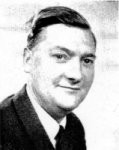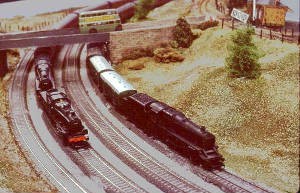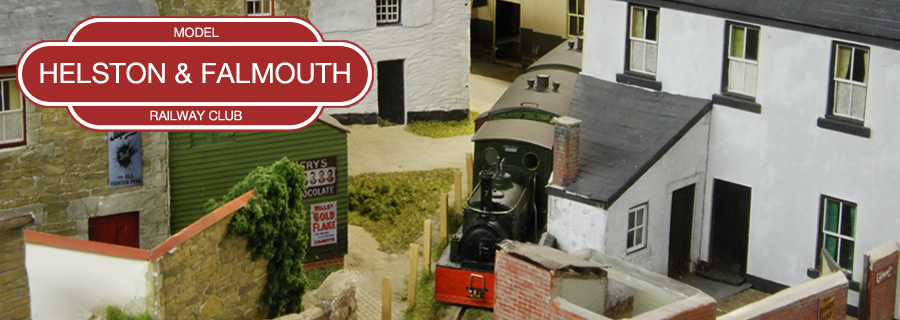Club History
The earliest model railways, around 1840, were clockwork 'carpet railways'. Electric trains began appearing around the turn of the 20th century, but these were relatively crude tinplate toys. Railway modelling as a hobby began in the 1920s, with live steam or clockwork models, but it was a pastime for the relatively wealthy and ‘0 gauge’ (7mm scale) was considered the smallest practical scale in which to build. Technology developed during World War 2 created electric motors small enough to fit inside model locomotive bodies allowing smaller scales to be introduced. Engineering techniques to make small precision components, originally for the War effort, were turned to making mass produced parts for miniature trains. The famous ‘Hornby Dublo’ of the post-War years sparked an interest in the possibilities of smaller scale railway modelling and many a schoolboy dreamed of a ‘Duchess’ or ‘The Flying Scotsman’ train set waiting to be unwrapped on Christmas morning.
Before the 1950s, attention focused mainly on building the locomotives and rolling stock, with little attention being paid to the surroundings through which the railways passed. But some modellers began to recognise the possibilities of placing the model railway into a realistic setting with landscape and buildings, stations and engineering works. Early modellers such as John Aherne, Edward Beal, P. D. Hancock and Peter Denny used the smaller scale of 4mm to the foot (00 gauge equivalent) to create authentic scenes through which the trains ran. This style of modelling had never been seen before, and the books and articles that these pioneers wrote in the 1950s and 60s inspired generations of enthusiasts to recreate their own miniature scenes.
Railway modelling clubs were rare in Britain in the early 20th century and only a handful existed in the early 1950s. Following the end of the austerity of the War years, interest in leisure pastimes and hobbies was beginning to revive and the benefits of collective endeavour manifested themselves in the building of larger layouts, not possible for the average individual. On the 15th January 1951, ten like minded individuals in the Falmouth area each contributed £1.00 (pounds, shillings and pence in those days) to secure a lease on a property in Falmouth with the intention of meeting to further their mutual interest in building railways in miniature, and the Falmouth Model Railway Club was founded. The Falmouth Model Railway Club occupied a variety of premises in and around Falmouth throughout the decades following its formation; old workshops; a sail loft; the former Social Club building of Falmouth Town FC in Arwenack Avenue, (which will be remembered by many older Falmouth residents for the Club’s summer open days); a school sports pavilion and a disused brewery were among its various homes. Over the years, the club developed a reputation both for fine modelling and placing its work on public exhibition originally with shows in the Falmouth ‘Poly’, local schools, and latterly the ‘Three Spires Railex’ held in Truro.
The Falmouth Model Railway Club occupied a variety of premises in and around Falmouth throughout the decades following its formation; old workshops; a sail loft; the former Social Club building of Falmouth Town FC in Arwenack Avenue, (which will be remembered by many older Falmouth residents for the Club’s summer open days); a school sports pavilion and a disused brewery were among its various homes. Over the years, the club developed a reputation both for fine modelling and placing its work on public exhibition originally with shows in the Falmouth ‘Poly’, local schools, and latterly the ‘Three Spires Railex’ held in Truro.
One of those members was the late L. F. Barham who owned a cycle and model shop in the High Street. He held a number of committee positions and later became president of the club. The club has occupied a number of properties including some workshops in Norfolk Road, a sail loft, accessed from the High Street down a flight of 80 steps and up a wooden staircase, and Arwenack Avenue, where we rented a large wooden building from Falmouth Town F.C.
From the outset the club has had a tradition of building exhibition layouts and holding exhibitions. One of the earliest was 'The West Cornwall Lines' which featured in the May 1955 edition of Railway Modeller and when exhibited at a show in the local Drill Hall, was viewed by over 4,500 people. The layout was 20' x 8' and consisted of a model of Truro station, goods yard and engine shed (83F), although condensed to two-thirds of the correct scale length.
 This tradition continued at Arwenack Avenue albeit on a more permanent basis, as the building contained not only a large layout room, but also a small cinema, the seats having been purchased from theclosed Gaiety Cinema in Newlyn, now the Meadery. During our time at this location, we ran an annual exhibition for two weeks in August, which involved opening the clubrooms daily from 10:30am - 9pm, except Sundays of course! The public were treated to a variety of trains on our club layout, which consisted of a four track mainline, a branch with intermediate station and passing loop. The main stations were Broome Junction consisting of six platforms, a goods yard, carriage sidings and motive power depot and Pendennis, a branchline terminus with two platforms, the main one holding ten coaches, a goods yard and an engine shed. One memorable feature of this layout was the Brunel style wooden viaduct, which at approximately six feet in length and nearly two feet high, was an imposing structure.
This tradition continued at Arwenack Avenue albeit on a more permanent basis, as the building contained not only a large layout room, but also a small cinema, the seats having been purchased from theclosed Gaiety Cinema in Newlyn, now the Meadery. During our time at this location, we ran an annual exhibition for two weeks in August, which involved opening the clubrooms daily from 10:30am - 9pm, except Sundays of course! The public were treated to a variety of trains on our club layout, which consisted of a four track mainline, a branch with intermediate station and passing loop. The main stations were Broome Junction consisting of six platforms, a goods yard, carriage sidings and motive power depot and Pendennis, a branchline terminus with two platforms, the main one holding ten coaches, a goods yard and an engine shed. One memorable feature of this layout was the Brunel style wooden viaduct, which at approximately six feet in length and nearly two feet high, was an imposing structure.
 Time moves on and following Falmouth Town F.C. constructing a new social club adjacent to their ground at Bickland Parc, we vacated Arwenack Avenue and for a year or so met in the basement of the local Buffalo's club.We then moved to the cricket pavilion of the former Falmouth Grammar School in Tregenver Road which became our home for nearly twenty years until 2001. With the loss of our permanent exhibition layout we set about building portable layouts, one of which was a joint project between one of our members and the club, called Roseladden & Tregenver The layout was built to S4 (18.83mm gauge) standards and was exhibited at number of local shows including the City Hall in Truro and the Guild Hall in Plymouth.
Time moves on and following Falmouth Town F.C. constructing a new social club adjacent to their ground at Bickland Parc, we vacated Arwenack Avenue and for a year or so met in the basement of the local Buffalo's club.We then moved to the cricket pavilion of the former Falmouth Grammar School in Tregenver Road which became our home for nearly twenty years until 2001. With the loss of our permanent exhibition layout we set about building portable layouts, one of which was a joint project between one of our members and the club, called Roseladden & Tregenver The layout was built to S4 (18.83mm gauge) standards and was exhibited at number of local shows including the City Hall in Truro and the Guild Hall in Plymouth.
During the 1990s, the club began to hold an annual exhibition again, initially at the Arts Centre in Falmouth, from 2001 at Trescobeas School and from 2006 at Truro, and later as 'The Three Spires Exhibition' at Truro School.
Building model railway layouts can be space consuming and finding suitable permanent, premises has always been a difficulty. With the recent rapid commercial expansion of Falmouth and Penryn, finding affordable premises the required size has become almost impossible. In 2009 the Club vacated its last Falmouth based headquarters and took over a redundant farm building at Gunwalloe, near Helston. Having spread its net wider, it also took the opportunity to amend its name to ‘Helston & Falmouth Model Railway Club’ emphasising its outward-looking approach to attracting membership from the wider area.
In 2013 we held our first exhibition at the Old Cattle Market, Helston; eventually we outgrew this space and took the opportunity to open out to the wider modelmaking community with 'The Great Cornish Model Show' at Pool Academy where individuals, groups and clubs can show their skills. Along with a wide range of working model railways, the event showcases radio controlled boats, aircraft and vehicles; static model ships, aircraft, military subjects and cars; plastic kit modelling; model engineers; LEGO builders; doll's houses and miniature rooms; card and paper modelling and vintage meccano and tinplate models. We also have great support from the Trade. The show takes place each April around Easter time at Pool Academy. More details on our Exhibitions page.
